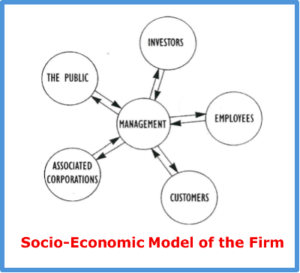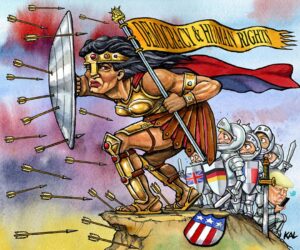Just a decade ago, Blockbuster ruled the movie rental business about the way its name implies. With 25,500 employees at 8,000 stores dispensing movie rentals and a parallel distribution system of 6,000 DVD public vending machines, it had $500 million in annual cash flow and was valued at $ 3 billion. About 2005 it was valued at $ 8 billion. [1]
Meanwhile, Netflix was using the postal service to distribute DVDs, and it didn’t seem to have a chance. Founded in 1997 by Reed Hastings, its prospects of surviving battles against Blockbuster, Wal-Mart, Amazon, Google, Microsoft, and other competitors looked so poor that a Wall Street analyst labeled its stock “a worthless piece of crap.”
Yet Blockbuster soon filed for bankruptcy, while Netflix gained leadership of the industry. Blockbuster lost $518 billion in 2010, running $ 1 billion in debt, and is closing most outlets. Netflix gained 16 million subscribers by running a well-executed operation and streaming movies online. The company earned $116 million in 2010, and its stock soared from $11 in 2005 to above $200 today, making Netflix worth about $13 billion. [2]
How did an upstart like Netflix succeed in beating an entrenched opponent like Blockbuster? It took good leadership, of course, but fundamentally it was because NetFlix executives understood that an emerging technology was rapidly changing the delivery of movie rentals. Hastings developed a strategy of Internet streaming, convenient customer service, and a virtual organization to deliver it cheaply and flawlessly. John Doerr, a partner at the venture capital firm Kleiner Perkins, said “Reed was ahead of the technology curve, and completely changed the industry.” [3]
Even when only few Americans had broadband in 2000, Hastings knew that renting video cassettes would soon yield to streaming movies over the Internet. Netflix was working on a TV box that would stream movies, but it required 16 hours of download time. Blockbuster also knew it was coming but would not take the plunge. Instead, they tried to beef up sales by expanding their stores into outlets for books, toys, and other merchandise – back to the future. [4]
When faster broadband and better video compression allowed YouTube and other Web 2.0 sites to erupt on the scene about 2005, Hastings realized that the time has come to cannibalize his DVD rental business in favor of streaming video. He also knew that developing a “box” was too limiting, and that an open-source approach would allow Netflix to distribute movies on TVs, DVD players, desk-top computers, mobile phones or almost any device. To help their customers give up DVDs, NetFlix did the unthinkable – they gave away streaming movies and made it easy. [5]
The second part of NetFlix’s technology strategy was to avoid the burden of retail outlets by operating online. With only a few warehouses and offices, the company became a virtual organization with no retail stores and no sales employees. A small staff operates on what Hastings calls their “Freedom and Responsibility Culture.” Instead of authorized vacations, sick days, and fixed work hours, people work when they choose as long as their job gets done. Titles and even compensation are up to the individual.
Finally, NetFlix improved on Blockbuster’s lackluster service and outmoded pricing. Blockbuster charged $5 cost for each movie, and people especially hated the fees for late returns. So Hastings used a monthly subscription that allows unlimited rentals and no late fees. Instead of renting movies, the focus is on providing a convenient service. To make it inviting to order movies online, NetFlix developed what is possibly the best software in the industry. At a time when most websites are a confusing mess, the website is a model of clean organization and intuitive clarity. Like most Web 2.0 sites, Netflix uses client responses to recommend movies for individual taste. They even offered a $1 million prize to anyone able to improve the rating system.
For the time being at least, NetFlix has set a new standard for the exploding market in movies and video – much the way Microsoft set the standard for desktops, the way Amazon gained dominance of book sales, and Goggle gets the majority of search. This stunning success propelled Hastings to the top of Fortune’s “2010 Businessperson of the Year” award.
What can be learned from this case? Netflix illustrates the central role that emeerging technology plays in transforming an industry. Because Hastings is a Stanford computer scientist and a Silicon Valley entrepreneur, he knew it would soon be feasible to stream movies, but he also knew the switch had to be timed quite precisely. Taking such a big risk too early would invite a bleeding-edge failure, while a few years later the field would be left to competitors. He also knew that having employees run shops, charging for rentals, late fees, etc. were outmoded relics of the past, while online service delivered by a virtual organization offered unbeatable value.
[1] Stephen Gandel, “How Blockbuster Failed at Failing,” Time (October 11, 2010)
[2] Cecilia Kang, “Is Dish Network’s new sidekick it’s secret weapon?” Washington Post (April 24, 2011)
[3] Michael V. Copeland, “Reed Hastings: Leader of the Pack,” Fortune (December 6, 2010)
[4] Copeland, “Reed Hastings”
[5] Cecelia Kang, “Netflix tunes in to competition in its queue,” Washington Post (March 6, 2011)




